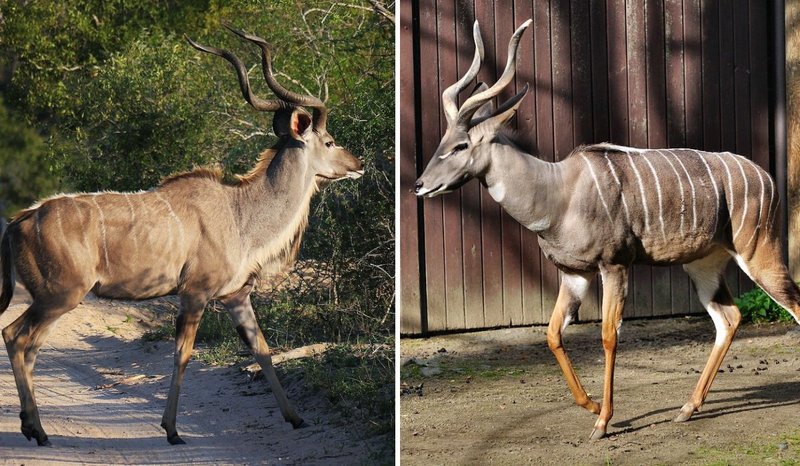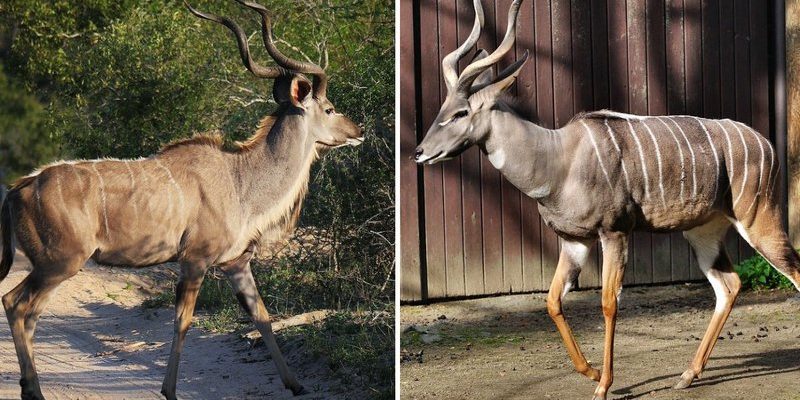
In this article, we’ll dive into 10 animals that are similar to the Greater Kudu. We’ll explore each one, highlighting their unique features and how you can easily tell them apart. Whether you’re an avid wildlife enthusiast or just someone who enjoys nature documentaries, understanding these animals can deepen your appreciation for the incredible diversity of life on our planet.
1. Lesser Kudu
The Lesser Kudu is like the little sibling of the Greater Kudu, smaller and often overshadowed by its bigger relative. These antelopes typically weigh between 75 to 100 pounds and stand about 3 feet tall at the shoulder. One key feature that sets them apart is their stripes. While both types of kudu have vertical stripes, the Lesser Kudu has thinner stripes and a more pronounced face mask.
You might spot Lesser Kudus in the dense bush and woodlands of East Africa, primarily in regions with plenty of cover. They are a bit shyer than their greater counterparts, making them a bit harder to find. If you see a kudu with large, rounded ears and a smaller, more delicate frame, you could be looking at a Lesser Kudu!
2. Nyala
Next up is the Nyala, another antelope that’s visually captivating. Nyala bulls are significantly more muscular and bulky than Greater Kudus, but they share a striking coat pattern. Males have a dark, shaggy coat with white stripes and a unique spiral horn that can reach over three feet in length. Female Nyala, on the other hand, are more slender and have a chestnut-brown color with lighter stripes.
You can typically find Nyala in brushy scrub and woodland areas in southern Africa. They are often more sociable than Greater Kudus, and you might see them grazing in small groups. If you notice an antelope with a boisterous demeanor and a shaggy appearance, it’s a good bet you’ve encountered a Nyala.
3. Sitatunga
The Sitatunga is a true water-loving antelope often found in swampy areas and marshes. They have a more elongated body and long, splayed hooves that help them navigate wet ground. Their coats are usually a reddish-brown color, with males displaying impressive spiral horns that can grow up to 36 inches long.
What sets the Sitatunga apart from the Greater Kudu is their affinity for water and their unique adaptations for a semi-aquatic life. If you observe an antelope wading through water or standing gracefully on a lily pad, it’s likely a Sitatunga flaunting its aquatic skills.
4. Impala
The Impala is one of the most common antelopes in Africa, known for its stunning leaps and agility. They are smaller and more slender than Greater Kudus and have a distinctive black stripe along their hindquarters. Impalas are social animals, often seen in large herds, which helps them evade predators through sheer numbers.
While both Impalas and Greater Kudus are graceful, Impalas are more acrobatic. If you see an antelope effortlessly bounding away with impressive jumps, chances are you’re witnessing an Impala in action and not a Kudu.
5. Bushbuck
The Bushbuck is another close relative of the Kudu but tends to be more compact and stocky. They have a shaggy, dark brown coat adorned with white markings and can be found in thick bush or forest habitats. Males grow twisted horns that can reach lengths of about three feet, but their sizes can vary significantly.
When comparing Bushbucks to Greater Kudus, look for the more rugged build and the general habitat. Whereas Kudus prefer more open environments, Bushbucks thrive in dense vegetation. If you’re in a lush area and spot a smaller, more reclusive antelope, it’s probably a Bushbuck taking cover.
6. Oribi
The Oribi is a petite antelope found in grasslands and savannas. They are significantly smaller than Greater Kudus, standing only about 2 feet tall. Despite their size, Oribis are known for their incredible agility and quick speed, which helps them escape predators.
Their coat is a lush tawny color, with a distinctive black stripe on their face. Telling Oribis apart from Greater Kudus is generally straightforward due to size alone. When you see a small antelope darting swiftly through tall grass, you’re likely witnessing an Oribi.
7. Bongo
The Bongo is a fascinating and beautifully patterned antelope primarily found in the rainforests of central and western Africa. With their striking reddish-brown coat and white stripes, they are one of the more visually stunning antelopes. Bongos are larger and more robust than Greater Kudus and possess impressive, spiral horns that can reach up to 39 inches.
Unlike Kudus, which often inhabit more open savanna areas, Bongos thrive in dense forests. If you spot a large antelope in a shaded, heavily vegetated area with a vibrant coat, it’s likely a Bongo.
8. Eland
The Eland is one of the largest antelopes in Africa, dwarfing the Greater Kudu in size. Males can weigh over 2,000 pounds, making them quite impressive. They have a light tan coat with vertical white stripes and large, spiraled horns.
Elands typically reside in open, grassy plains and are known for their calm demeanor. While Kudus have those elegant, long legs, Elands have a more robust, stocky build. If you’re comparing size, the larger, more powerful antelope is surely an Eland.
9. Gerenuk
The Gerenuk, sometimes called the “long-necked antelope,” stands out with its unique posture and feeding habits. They are smaller than Greater Kudus and have a long neck and legs. Gerenuks are capable of standing on their hind legs to reach higher branches, a trait that is pretty rare among antelope.
Their slender bodies and long necks make distinguishing them from Greater Kudus quite easy. If you see an antelope reaching up for leaves, it’s likely a Gerenuk showing off its impressive stretching skills.
10. Addax
Lastly, the Addax, or white antelope, is among the rarest of all antelope species. They are adapted to life in the desert and have a striking white coat with twisted horns that can grow up to 39 inches long. Addaxes are smaller than Kudus and are known for their ability to survive with minimal water.
While Greater Kudus prefer more vegetated areas, Addaxes thrive in arid environments. When observing these unique antelopes, their pale coloration and arid habitat are key indicators that you’re looking at an Addax and not a Kudu.
Understanding The Differences
While all these animals share some characteristics with the Greater Kudu, each has its own unique features that set them apart. Pay attention to differences like size, habitat, coat patterns, and social behavior. Whether you’re out on a safari or just exploring wildlife documentaries, knowing these details can enhance your appreciation of Africa’s rich wildlife tapestry.
So the next time you admire a Greater Kudu, remember there’s a whole world of similar antelope out there, each with its own story and uniqueness. Enjoy exploring the wilderness, and who knows? You might just spot one of these fascinating creatures unique in its own right!

